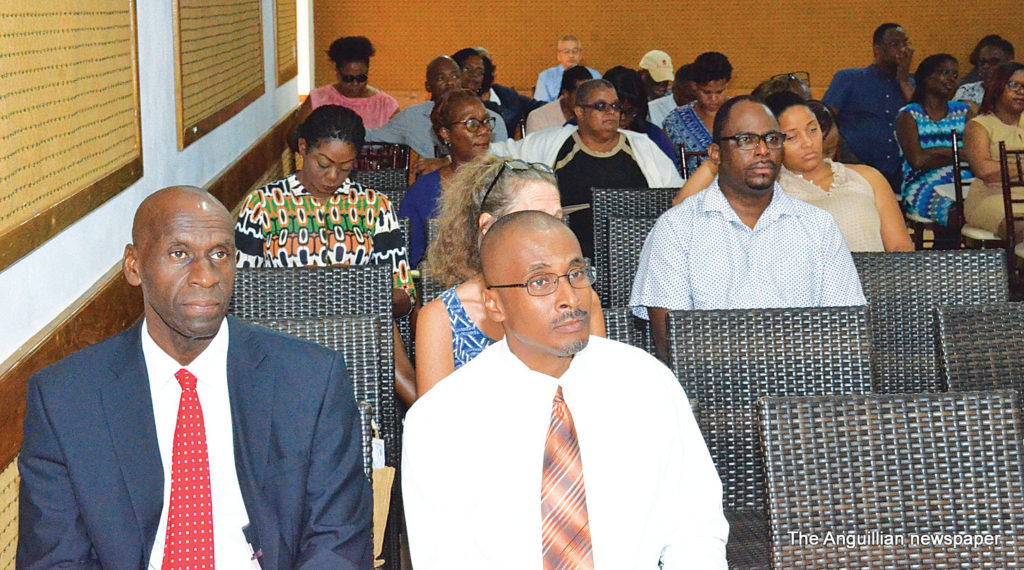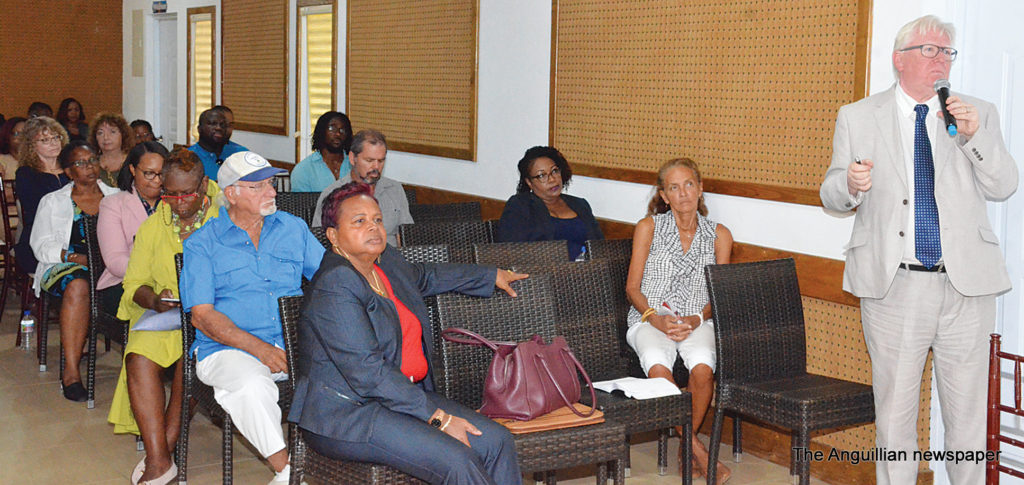
Whether you like it or not, the phased Goods and Services Tax (GST) is coming to Anguilla as from September this year, but beginning at a low rate – much lower than anywhere else.
That terse message was delivered by the Permanent Secretary in the Ministry of Finance of the Government of Anguilla, Dr. Aidan Harrigan. He was speaking at a meeting called by the Chamber of Commerce and Industry. The meeting involved the business community and two well-experienced consultants, Mr. Glenville John of St. Vincent and the Grenadines, and Mr. Mark Waddington of the United Kingdom.
The meeting, chaired by Director of the Chamber, Ms. Sandra Lowell, was held at La Vue Conference Centre on Tuesday, July 9. Addressing the considerably large gathering, Dr. Harrigan said in part: “The purpose of the meeting is not to debate whether or not Goods and Services Taxes will be implemented. That has already been decided by the Government. Whether you agree or disagree that’s your prerogative. We trust that the meeting would be done in a good spirit, showing respect and so on.”
The first presenter, Mr. John, said the Chamber of Commerce and Industry was a very important stakeholder when it came to tax and other business-related reforms in any jurisdiction. He was commenting on the Chamber’s initiative to call for the explanatory meeting. He dealt especially with the phase one aspect of the GST while his colleague, Mr. Waddington, presented the phase two provision.
Giving some of the reasons for Anguilla’s decision to introduce the GST, Mr. John observed that the island was required to conform with certain international trends having been grossly lagging behind. He noted that, for instance, the focus of the World Trade Organisation was to phase out Import Duty eventually, and to ensure free trade – a step that Anguilla must take, while replacing it with other revenue measures such as the Goods and Service Tax or VAT as it is also referred to.

The Tax Administrator continued: “Presently, there are too many Import Duty rates in Anguilla. Actually, there are eight – far too many. The current tax structure of Anguilla is out of date. If you look at what is happening internationally, and compare that to what is happening in Anguilla, you will soon realise that Anguilla is way behind in terms of international trade and negotiations. The Harmonised System [Tariff] being used now by Customs in Anguilla is HS 2007 while the World International Trade is using HS2017 and there was also an HS2012. Anguilla has missed HS2012 and we are now in HS2017…You may find that there are goods that are being classified in Anguilla wrongly because they are not up to date with the new HS2017. Anguilla is still using the Brussels definition of value for imported goods. International Trade has long gone past that.”
Mr. John also noted that there was a need in Anguilla to encourage growth in the manufacturing sector. “I look at Anguilla and I see a small manufacturing sector virtually begging for the kind of nurturing that is necessary to allow it to be better,” he stated. “It is an area where a lot of people who have ideas, innovations and so on, can really invest and venture out to help to grow the economy.”
He went on: “There are three phases of the GST. Phase one involves the reform of the International Trade Taxation Structure and this will be rolled out sometime this year [September the tentative date]. In phase two, there will be the partial introduction of the GST and that is slated for January 2021. Then there is phase three which is the adoption of the full GST, and that is scheduled for January 2023.
“Phase one is essentially a revenue exercise. There will be a reduction of the number of Import Duty rates from eight to four, and a reduction of the averaged rate from 12.9 percent to about 8. There will be the creation of a Customs Service fee of 1 percent of the CIF value of imported goods; the introduction of an Excise tax duty on alcohol and non-alcoholic beverages, confectionaries, tobacco, vehicles and so forth; and there will be a transformation of the Customs Service charge into an Interim Goods Tax with a rate of generally about 9 percent. This excludes those goods that are presently zero-rated.”
Mr. John, who spoke about various complex, technical and legal matters, relating to the Goods and Services Tax, said that there was a plan to update Anguilla’s Customs Harmonised System from 2007 to HS2017. In that way, when Anguilla trades internationally, it will be based on the latest system on the market. “We don’t want when you order goods from Europe or North America that the classification there is different from the classification in Anguilla,” he stressed. “It distorts the way you conduct your trading activities – and so it is not advisable that Anguilla continues along that path.”
Mr. Waddington, the other presenter, also went into much detail on various matters related to phases two and three of the GST including the number of services for which the tax is payable, the registration requirements to be met – and other matters covered by the several pieces of legislation governing the Goods and Services Tax.
After an exhaustive presentation, he outlined the ultimate objectives of the Goods and Services Tax. They are as follows:
• To establish a modern efficient tax system in Anguilla;
• Establish efficient, effective and fair tax administration;
• Provide the means for the Government of Anguilla to meet its budgetary obligations;
• Achieve tangible benefits for all citizens of Anguilla: better roads, education, refuse services and general infrastructure.
The two presentations lasted for some two and a half hours and were followed by an interactive session of questions and answers.
Persons desirous of further information regarding the Goods and Services Tax, and the three pieces of enabling legislation that have already been passed through the Anguilla House of Assembly, should check the Government’s website.







